► New Land Cruiser meets custom restomod
► We take new Toyota 4×4 on US road trip
► On the trail with FJ40 by Icon4x4
The billboards are impossible to miss. One reads ‘Tattoo Mick – Real Estate’ and displays a huge photo of Mick in all his inky glory. Another extols the virtues of a treatment for varicose veins. A liquor store promotes the local Pride Week. Another board address a plea to God… and on it goes, telling the story of modern America as vividly as any podcast, newsfeed or movie.
Our transport through this huge and storied land is the huge and storied Toyota Land Cruiser. It may not be what you first think of in a US context – it’s perhaps more readily associated with aid agencies in Africa, farmers in Australia, drilling engineers in the Gulf – but it’s a big seller here. It manages to straddle many cultural divides and appeal to both urban and rural dwellers, and achieves the rare feat of being a car with cult appeal from a huge manufacturer.
There have been times, though, when it seems that of all the people in the Land Cruiser’s orbit, it’s Toyota that has the shakiest grasp of its appeal. Whereas Land Rover with the Defender, Jeep with the Wrangler and Daimler with the Mercedes G-Class all trade heavily on heritage, Toyota has occasionally let the Land Cruiser drift away from the optimal mix of retro ruggedness and full-on functionality.
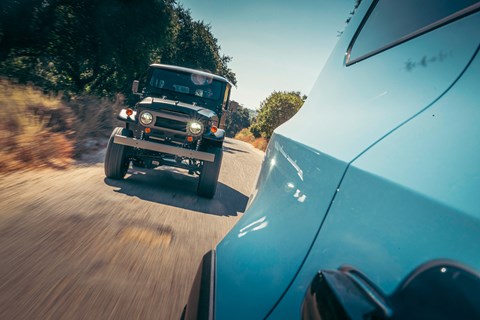
That’s done no harm at all to the customisers who do good business making new 4x4s look old, or bringing old 4x4s up to date. People like Icon4x4, makers of the car you see here alongside the all-new showroom Land Cruiser.
I ask founder Jonathan Ward to spell it out: why Toyota?
‘It’s one of two things. You’ve got the weird kid in school – while everyone else wanted a Jeep or a Bronco, they wanted to be more unique and hunted down an old Land Cruiser. Or, the dominant market [reason] in the US is world-travelling Americans – that’s what got me into the Land Cruiser. So when you’re where your vehicle is literally the difference between life and death, yeah, the Land Cruisers are everywhere.’
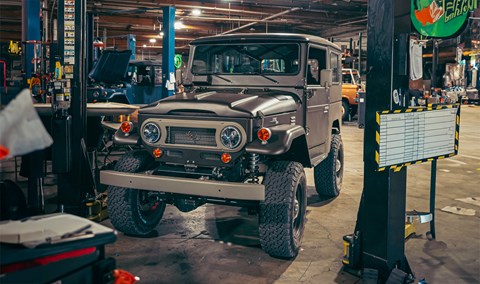
Ward’s a retired actor, but also a massive engineering geek. ‘The appreciation for the modularity, the quality of engineering and construction of the old FJ40 – once you get into it, it’s like, holy shit. The early series Landies have that same modularity and simplicity, but the foresight of Japanese engineering and design, in my opinion, took it to the next level.
He loves the details – things like the use of floating caged nuts on the door hinges, or the way you can fold the grille down and the engine comes out of the front in one relatively simple movement.
Does the modern car satisfy that nerdiness? Ward isn’t convinced. ‘The Land Cruiser was traditionally designed, engineered and built by a completely separate division. Now it’s pretty much merged into Toyota. Hence the new Land Cruiser – lovely, by the way – is not built to the engineering ethic of durability and simplicity that even the Land Cruiser you saw me pull up in.’ That’s a 100 Series car, the version introduced at the end of the ’90s.
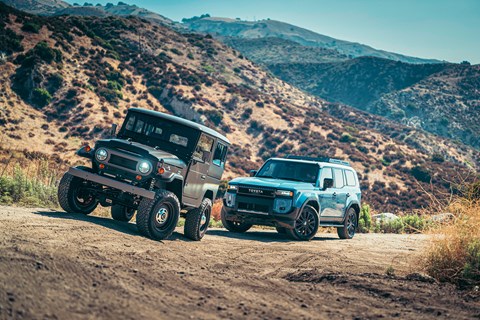
The relatively luxurious and advanced 200 Series that replaced it was, for some, too upmarket and generic. Yes, clearly, a car that’s been around in one form or another since 1951 needs to modernise in response to changing expectations. But you can see why enthusiasts would worry that the trend would continue and the Land Cruiser would lose its distinct identity.
You can understand this sense of trepidation. The new version, the 250, might ride on the same body-on-frame principles that have defined the Land Cruiser since the era of Truman and the Korean War, but it’s also shifted with the times. There’s a hybrid. And a touchscreen. And a graphic that tells you what the speed limit is. Not quite running with the Land of the Free vibe.
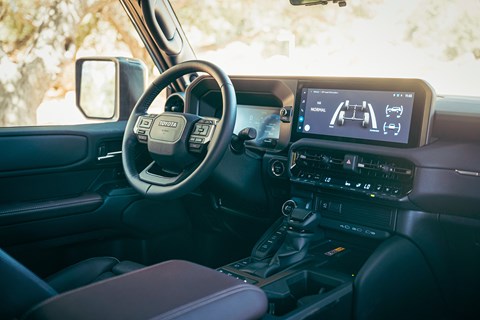
But it turns out Toyota sees the value of its heritage. The claim is that the 250 is ‘returning to its original role and mission’. (If you want something more luxurious, some markets offer the plush 300, and there’s also an ultra-basic, clean-with-a-stiff-brush 70 Series.)
Our blue 250 is more or less the version sold everywhere. This one has a 2.4-litre hybrid four-cylinder engine, driving all four wheels via an eight-speed auto; the UK equivalent has a 2.8-litre diesel. It has low and high range, plus the ability to lock the centre and rear diffs and remotely disconnect the front anti-roll bar to give more axle articulation. There’s also Toyota’s equivalent of the Terrain Select feature you find in Land Rovers, where you scroll through the various surfaces from snow to mud and select the appropriate setting using electronic switches, not physical levers.
Contrast that with the Icon FJ40 we’re in where levers and brute force are required to change its mood. It’s a beautiful reimagining of the original; think of Icon4x4 as being to Toyota Land Cruisers what Singer is to the Porsche 911.
Ward shows us around his workshop and it’s clear that here is a brain that doesn’t rest easily. There’s what looks like a knackered Chevy truck in one corner, but in reality is a brand-new Silverado 2500 with an ancestor’s body on it: ‘Reskinned to look more vintage appropriate.’
I’m not sure I’ve ever come across someone who is so driven, so all-knowing, so incredibly into the detail and yet also the big picture. Frankly, it’s a bit exhausting just talking to him, trying to concentrate on the vast topics he covers. His wife had an operation the day before we arrived and yet here he is, spending time with us on a Saturday and never even thinking of cancelling at the last minute. And bear in mind that all this is relatively recent – it’s a successful second career for Ward, after many years as a full-time actor. Arnie was merely dabbling in an alternative career path compared to Ward.
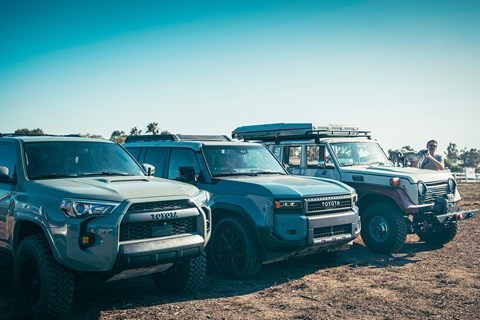
For vehicle classification purposes in the US market, this FJ40 is a restomod – but in reality, it’s an all-new car. Icon has to keep a structural aspect of the original firewall and the front bib (where the front grille hinges down), but everything else is brand new and engineered like the space programme. Every car from Icon4x4 looks unique but in reality repeatability is key, because once a production process is in place it brings down costs.
So it’s an all-new chassis running coil-over suspension with 12-inch travel and Fox dampers, all suitably beefy to cope with whatever the owners can throw at it. At the front is GM’s LS3 small-block V8 engine with 430bhp and 450lb ft. A manual gearbox is available but ours is running a four-speed auto.
The body is powder-coated and the chassis is covered in heat-cured polyurea: no awkward aluminium/steel galvanic corrosion here. Leaning on the front wheelarch to talk to Ward, you notice that it doesn’t flex at all. It has the solidity of a planet.
I swoon over the details. The aluminium push/pull levers for the lights and air-conditioning control have a smooth texture that I could stroke all day long. They’re based on the plastic ones from the 70 Series but, in typical Icon fashion, Ward has designed his own graphic for the routing of the heating system and temperature knobs, as those particular functions weren’t available originally.
The bonnet catches make me giddy. This might be the first time in CAR’s history that someone has dedicated an entire paragraph to a bonnet catch but bear with me.
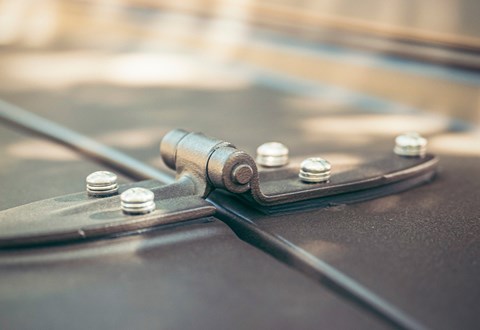
I own a 1955 Jeep and it’s a pain in the backside to open the bonnet because the catches don’t swing away when they’re released. They keep snagging it closed. But in the Icon, Ward has engineered a sprung catch so it moves out of the way when you want it to, and stays out of the way. But the spring doesn’t simply ping it away, it glides beautifully, moving with the grace of a ballet dancer. I’d buy one on the strength of that alone.
It’s organic, cared-for, rigorous. A thing of great mechanical beauty. And, in use, incredibly capable, although it’s not without its foibles. I’m glad of my experience in the old Jeep as, at low speeds, the FJ has the same sort of vagueness about the controls. You have to learn to let it plough its own furrow, rather than gripping the wheel with the ⊲ strength of a monkey wrench, and relax into it.
When we’re out of the suburbs and at higher speed it starts to settle, and off-road is where it truly comes into its own. This particular FJ is a customer’s car and is worth $320,000 (including the donor vehicle) so it seems wise to let Ward do the driving on some fast but rough gravel tracks. The flex in the steering is now vital, so that the 286/65 R18, all-terrain Goodrich tyres don’t tear it out of his hands as we come across gullies and rocks. They’re the sort where you wince in advance but the FJ just floats over them. It’s incredible, reminding me of the time when I had a go in a rally-raid car; the FJ has the same damping control.
Ward loves this. He makes sure that all the cars that leave the workshop get a good number of miles on them before they go to the customers, telling us that it needs to be right for quality control. But he clearly also just delights in driving them.
The V8 with the side-exit pipe is glorious when you start it up, with a lovely, low-speed burble that instantly evokes every classic American engine ever, but in reality it’s surprisingly quiet at speed.
That character is what’s missing from the 250 Land Cruiser. This isn’t a comparison test between the two – no one is cross-shopping a box-fresh 250 with a $320,000 restomod FJ40. But you can’t help but notice there’s a lightness of touch in the new car that you don’t get in the old, a sense that while it’s well made in modern terms, it lacks the heft and solidity of the Icon FJ.

We’re only on road tyres and I’ve promised Toyota I won’t subject the new car to any hardcore off-roading today, but you can feel the fundamental differences between the two when you get to a gravel track. The new car copes with it – obviously it does– but where the Icon leaps at the scenery like a terrier trying to get at a chicken coop, the new Land Cruiser feels more aloof.
Like the cultural divide – urban vs rural – that it needs to straddle, the Land Cruiser is a car that never really settles. It’s comfortable and quiet, with precise steering and good grip levels, but you can feel the presence of the traditional ladder-frame chassis as soon as you drive down the road. It rolls through corners more than a modern, monocoque SUV and doesn’t have the same levels of body control. Those are not concerns when you’re hitting the trail at the weekend; then, chassis flex can be a very good thing. But when you’re ferrying the kids to school during the week, it might feel rather crude and wallowy. As Toyota has tried to widen its appeal, you suspect that in some ways the car has fallen between two stools.
We peel away from Icon feeling reassured that the world is a fine place, if slightly doubtful that Toyota can manage the nigh-on impossible job of continuing to combine cult appeal with mass acceptance, despite the new car’s laudable attempt at a back-to-its-roots design. But it turns out we may be over-thinking it. It all starts to make sense when we visit a Land Cruiser meet. We’re slightly apprehensive, given that the event is sponsored by Huf, a ‘pioneering skate and lifestyle brand’ that doesn’t sound much like our cup of tea at all.
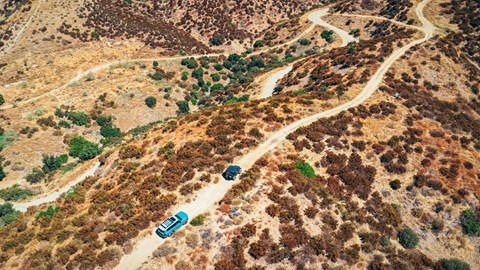
And then we arrive. We’re just a stone’s throw from Malibu beach and surrounded by gentle rolling hills dotted with vines; a glorious venue for anything. And we’re met by Land Cruisers of every stripe – no two the same. Some are lifted, others have roof tents; one guy comes in with the coolest patina’d 70 Series and then defies the macho image by letting two yappy dogs out of the passenger door.
And whatever it was about the Huf branding that was putting us off now seems fine. There’s a tremendous feelgood vibe about the whole event. The display area has another dozen cars on show, including two brand new 250s that have been tricked out with different suspension and massive tyres. Ours looks weedy in comparison. I get chatting to a guy called Steve who owns them both and has a modifying shop in LA: ‘I love them because it gets away from the normal. You can’t take the family out in a sports car and the Toyota has that appeal of being durable and affordable. They’re easier to modify – like, Nissan doesn’t offer any aftermarket support. Even the base car gets a rear locker [diff] so modders don’t need to worry.
‘The new one is true to what it should be. Yeah, it’s got a four-cylinder but that’s the environment we live in, man.’
A chap parked next door volunteers his opinion from the driver’s seat of his 80 Series, a car that’s been modded for camping, has done 263,000 miles and is ‘barely run-in’. ‘The Land Cruiser is a leveller, where you don’t have to be a millionaire to be a collector. The barrier to entry is low but the fun factor is much higher.’
That’s the key with the new car. Keep the reliability high and the costs low – that way, Toyota might just span the cultural divide; Icon will still thrive for the top-end as the heritage will remain, but the local modding scene will be the base feeding it all. It’s a cult that, for once, has a future.
The best 4x4s